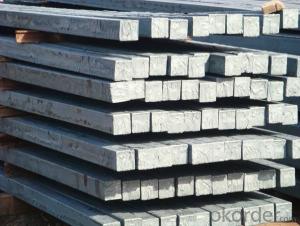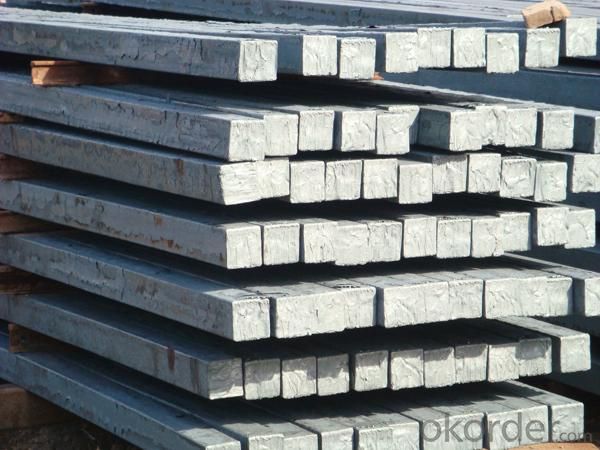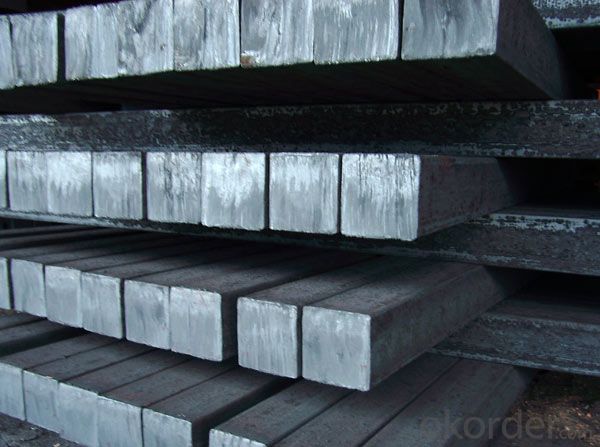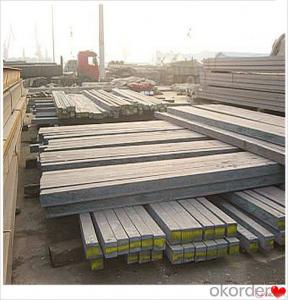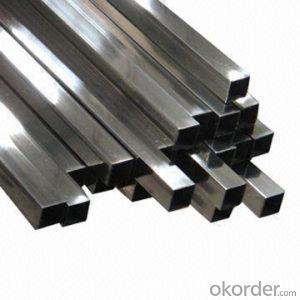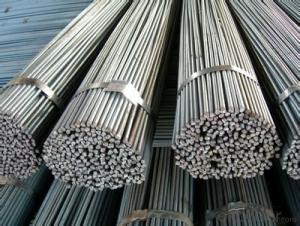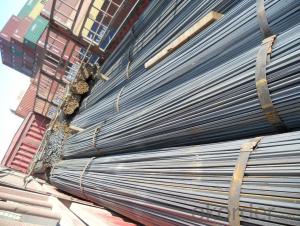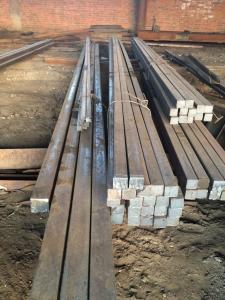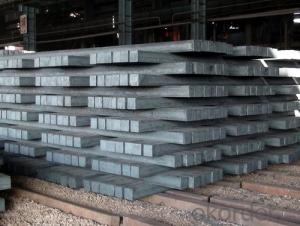Hot Rolled Square Bar with High Quality of Grade Q235,Q275
- Loading Port:
- Tianjin
- Payment Terms:
- TT or LC
- Min Order Qty:
- 3000 m.t.
- Supply Capability:
- 100000 m.t./month
OKorder Service Pledge
OKorder Financial Service
You Might Also Like
Product Description:
OKorder is offering Hot Rolled Square Bar with High Quality of Grade Q235,Q275 at great prices with worldwide shipping. Our supplier is a world-class manufacturer of steel, with our products utilized the world over. OKorder annually supplies products to European, North American and Asian markets. We provide quotations within 24 hours of receiving an inquiry and guarantee competitive prices.
Product Applications:
Hot Rolled Square Bar with High Quality of Grade Q235,Q275 are ideal for structural applications and are widely used in the construction of buildings and bridges, and the manufacturing, petrochemical, and transportation industries.
Product Advantages:
OKorder's Hot Rolled Square Bar with High Quality of Grade Q235,Q275 are durable, strong, and resist corrosion.
Main Product Features:
· Premium quality
· Prompt delivery & seaworthy packing (30 days after receiving deposit)
· Corrosion resistance
· Can be recycled and reused
· Mill test certification
· Professional Service
· Competitive pricing
Product Description:
-Standard: Q235 Q275
--Chemical Composition:
Standard | Grade | Element (%) | ||||
GB | Q235/275 | C | Mn | S | P | Si |
0.06~0.12 | 0.25~0.50 | ≤0.050 | ≤0.045 | ≤0.30 | ||
Measures of HR Square Bar (small measures):
(Section of HR Square Bar)
-Length of a side and Theoretical weight of Square Bar.
Length of a side(mm) | Theoretical weight(kg/m) | Length of a side(mm) | Theoretical weight(kg/m) |
7 | 0.385 | 22 | 3.80 |
8 | 0.502 | 24 | 4.52 |
9 | 0.636 | 25 | 4.91 |
10 | 0.785 | 26 | 5.30 |
11 | 0.950 | 28 | 6.15 |
12 | 1.13 | 30 | 7.06 |
13 | 1.33 | 32 | 8.04 |
14 | 1.54 | 34 | 9.07 |
15 | 1.77 | 36 | 10.17 |
16 | 2.01 | 38 | 11.24 |
17 | 2.27 | 40 | 12.56 |
18 | 2.54 | 42 | 13.85 |
19 | 2.82 | 45 | 15.90 |
20 | 3.14 | 48 | 18.09 |
21 | 3.46 | 50 | 19.63 |
Notes:
1, The theoretical weights in the list, base on the density of 7.85 g/cm3.
2, Formula for theoretical weight of Square bar: (length of a side)2 * 0.00785
3, The numbers with *mean that they are not regular or we don’t offer them.
-Regular length of Square Bar:
Steel | Length of a side (mm) | Length of steel (m) |
Normal steel | < 25 | 4~10 |
> 25 | 3~9 | |
Steel of high quality | All measure | 2~6 |
Tool steel >75 | 1~6 |
Usage/Applications of HR Square Bar:
-The Square Bar is normally used as structure steel.
-Row material for other structure steel like steel angles, channels, I-beams, H-beams, etc…
Packaging & Delivery of HR Square Bar:
-Packing Detail: The products can be packed in bundles by steel wires.
-Marks: We make tag marks and color marks. The tag marks with white background and red company logo will be tied up to each bundle of the products. The information is usually including basic information of products and company and other information requested by customers. As for color marks, we will paint both ends of bundles to make sure that it will be more convenient for customers to distinguish them from other products.
-Delivery Detail: 30~45 working days after receive buyer’s T.T. or L/C.
Transportation:
-The products can be delivered by bulk vessel or by container. As for container, products with the length of 6m will be loaded in 20’ container, with 9m or 12m, in 40’ container.
-The maximum quantity of loading of container is 25 tons.
-The products are usually transported to the nearest port from the production place.
FAQ:
Q1: Why buy Materials & Equipment from OKorder.com?
A1: All products offered byOKorder.com are carefully selected from China's most reliable manufacturing enterprises. Through its ISO certifications, OKorder.com adheres to the highest standards and a commitment to supply chain safety and customer satisfaction.
Q3: How soon can we receive the product after purchase?
A3: Within three days of placing an order, we will begin production. The specific shipping date is dependent upon international and government factors, but is typically 7 to 10 workdays.
Q4: What makes stainless steel stainless?
A4: Stainless steel must contain at least 10.5 % chromium. It is this element that reacts with the oxygen in the air to form a complex chrome-oxide surface layer that is invisible but strong enough to prevent further oxygen from "staining" (rusting) the surface. Higher levels of chromium and the addition of other alloying elements such as nickel and molybdenum enhance this surface layer and improve the corrosion resistance of the stainless material.
Image:
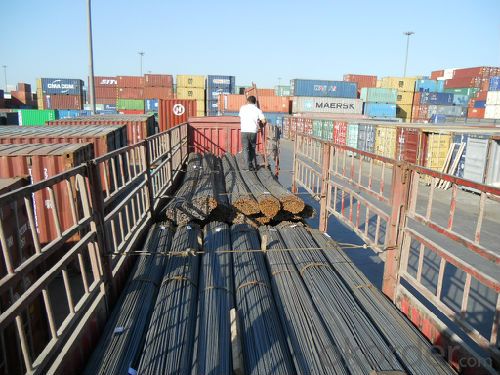

- Q: How do steel billets contribute to the overall cost-effectiveness of a structure?
- Steel billets play a crucial role in enhancing the overall cost-effectiveness of a structure in multiple ways. Firstly, steel billets are manufactured through a highly efficient process that ensures minimal wastage of raw materials. This efficiency significantly reduces the production cost of steel billets, making them a cost-effective choice for construction projects. Moreover, steel billets possess exceptional strength and durability, enabling them to withstand heavy loads and adverse weather conditions. This strength eliminates the need for frequent repairs or replacements, saving significant costs in the long run. Additionally, the durability of steel billets ensures the longevity of the structure, reducing maintenance expenses and enhancing cost-effectiveness. Another significant contribution of steel billets to cost-effectiveness lies in their versatility. Steel billets can be easily molded and shaped into various forms, allowing for customization and precise engineering in constructing the structure. This versatility eliminates the need for excessive material wastage and enables the optimization of resources, thereby reducing costs. Furthermore, steel billets have excellent fire resistance properties, making them a safe and reliable choice for structures. By minimizing the risk of fire-related damages, steel billets contribute to reduced insurance costs for the structure, enhancing its overall cost-effectiveness. Lastly, steel billets are often produced using recycled steel, which not only reduces the environmental impact but also lowers the production cost. This eco-friendly aspect further enhances the cost-effectiveness of a structure by reducing the overall carbon footprint and making it more sustainable in the long term. In conclusion, steel billets contribute to the overall cost-effectiveness of a structure by minimizing material wastage, providing strength and durability, offering versatility in design and engineering, ensuring fire resistance, and promoting sustainability. These factors collectively reduce production, maintenance, repair, and insurance costs, making steel billets an economically beneficial choice for construction projects.
- Q: What are the different shapes available for steel billets?
- Steel billets are manufactured in various shapes to cater to the diverse needs of different industries. Some of the available shapes for steel billets include: 1. Square Billets: These billets have equal sides, forming a square shape. They find extensive use in the construction industry for manufacturing beams, columns, and other structural components. 2. Round Billets: These billets have a circular cross-section and are commonly utilized in the production of seamless pipes, tubes, and rods. They are also employed in the automotive and aerospace sectors for manufacturing various components. 3. Rectangular Billets: These billets have unequal sides, forming a rectangular shape. They are frequently used in the construction industry to manufacture frames, window profiles, and other structural elements. 4. Hexagonal Billets: Hexagonal billets have six equal sides, forming a hexagon shape. They are commonly employed in the production of bolts, nuts, and other fasteners that require a hexagonal shape for proper fitting. 5. Octagonal Billets: Octagonal billets have eight equal sides, forming an octagon shape. They are often used in the manufacturing of special components and tools that require a unique shape for specific applications. 6. Slab Billets: Slab billets have a rectangular cross-section with a larger width compared to their height. They are primarily used for producing flat-rolled steel products such as sheets, plates, and coils. 7. Bloom Billets: Bloom billets have a square or rectangular cross-section with a larger size compared to regular billets. They are commonly utilized in the production of sections, bars, and rails. The choice of steel billet shape depends on the specific requirements of the desired end product and the manufacturing process involved. The versatility of steel billets makes them suitable for a wide range of applications in various industries.
- Q: How are steel billets used in the manufacturing of construction equipment?
- Steel billets are a crucial component in the manufacturing of construction equipment. These billets, which are essentially semi-finished steel products, serve as the primary raw material for creating various components and structures used in construction machinery. One of the main applications of steel billets in construction equipment manufacturing is for forging and casting processes. Billets are heated to high temperatures and then forged or cast into different shapes and sizes based on the specific requirements of the equipment being produced. Components such as gears, connecting rods, axle shafts, and hydraulic cylinders are commonly manufactured using this method. Furthermore, steel billets are also used in the production of structural components in construction equipment. These billets are typically shaped into beams, columns, and plates through hot rolling or cold drawing processes. These structural components provide the necessary strength and stability to the construction equipment, ensuring durability and long-lasting performance. Moreover, steel billets are utilized in the fabrication of frames and chassis of construction machinery. The billets are cut, shaped, and welded together to form a robust and sturdy framework that serves as the backbone of the equipment. This framework provides structural integrity, support, and rigidity to the construction equipment, allowing it to withstand heavy loads, vibrations, and harsh working conditions. In addition to the aforementioned applications, steel billets are also used to create other essential parts of construction equipment, such as buckets, blades, cutting edges, and tracks. These parts are crucial for the efficient operation of machinery like excavators, bulldozers, cranes, and loaders. Overall, steel billets play a vital role in the manufacturing of construction equipment by providing the necessary raw material for forging, casting, and fabricating various components and structures. The use of high-quality steel billets ensures that the construction equipment possesses the required strength, durability, and resilience to perform optimally in demanding construction environments.
- Q: How do steel billets contribute to the overall durability of a product?
- Steel billets are an essential component in the manufacturing process of various products, and their contribution to the overall durability cannot be overstated. These billets are semi-finished steel products that are used as raw material for further processing in industries like construction, automotive, and manufacturing. One of the primary reasons why steel billets contribute to the overall durability of a product is their superior strength and toughness. Steel is known for its exceptional mechanical properties, including high tensile strength and resistance to deformation, making it an ideal choice for applications that require durability. By using steel billets as the starting material, manufacturers can ensure that the final product will possess the necessary strength to withstand heavy loads, impacts, and other external forces. Moreover, steel billets have excellent corrosion resistance. Steel, when properly processed and treated, can resist rust and other forms of corrosion caused by moisture, chemicals, or environmental factors. This corrosion resistance greatly enhances the durability of the final product, as it prevents degradation and extends the lifespan. Another advantage of using steel billets is their versatility in terms of customization. Manufacturers can shape and form the billets into various sizes and dimensions according to the specific requirements of the product. This flexibility allows for the production of components that perfectly fit together, reducing the risk of weak points or vulnerabilities in the overall structure. Additionally, steel's malleability and ductility enable it to be easily molded and welded, further enhancing the overall strength and durability of the final product. Furthermore, steel billets undergo rigorous quality control measures during the manufacturing process. These measures ensure that the billets meet strict industry standards and specifications, guaranteeing their reliability and consistency. The high-quality steel billets, in turn, contribute to the overall durability of the product by providing a strong and reliable foundation. In summary, steel billets play a pivotal role in enhancing the overall durability of a product. Their exceptional strength, corrosion resistance, versatility, and high-quality attributes make them an ideal choice for industries that prioritize durability. By utilizing steel billets as the raw material, manufacturers can create products that are capable of withstanding demanding conditions, ensuring longevity and customer satisfaction.
- Q: What are the main factors that affect the international trade of steel billets?
- The international trade of steel billets is affected by various factors. These factors include the state of the global economy, government policies and regulations, currency exchange rates, technological advancements, environmental and sustainability considerations, and political stability and geopolitical factors. The global economy plays a vital role in determining the demand and supply of steel billets. Economic growth and stability in major importing and exporting countries impact the overall demand for steel products. A strong economy leads to increased construction and infrastructure projects, boosting the demand for steel billets. Government policies and regulations significantly impact the international trade of steel billets. Trade policies, import/export regulations, and tariffs imposed by governments can directly affect the competitiveness and cost of steel billets in the international market. Currency exchange rates influence the competitiveness of steel billets in international markets. Fluctuations in exchange rates can affect the demand and prices of steel billets. Technological advancements in steel production and manufacturing processes affect the international trade of steel billets. Improvements in production efficiency and the development of new steel grades can give certain countries a competitive advantage. Increasingly, environmental regulations and sustainability concerns are becoming important factors in international trade. Countries with stricter environmental regulations may require steel billet exporters to meet certain standards or obtain certifications, affecting their competitiveness. The demand for sustainable and low-carbon steel products also influences the trade of steel billets. Political stability and geopolitical factors can impact the international trade of steel billets. Political instability, conflicts, or trade disputes can disrupt supply chains and create uncertainties in the international trade of steel billets. In conclusion, the international trade of steel billets is influenced by economic, regulatory, technological, environmental, and geopolitical factors. Stakeholders in the steel industry need to understand and monitor these factors to make informed decisions in the global market.
- Q: How are steel billets stored and transported?
- Steel billets, which are used for further processing, are carefully stored and transported to maintain their quality and safety. In terms of storage, steel billets are kept in designated areas within steel plants or warehouses, equipped with proper ventilation, drainage, and protection from the elements. They are organized in stacks with enough space between them for easy accessibility and inspection. To maximize space, steel billets are often stored vertically in racks or on specially designed shelves. This allows for easy handling and transportation. When it comes to transportation, heavy-duty equipment such as cranes or forklifts are used to move the billets safely, minimizing the risk of damage or injury. Chains or straps are used to secure the billets and prevent movement during transit. For longer distance transportation, steel billets are loaded onto trucks, trains, or ships. Containers or trailers are chosen based on the size and weight of the billets to ensure stability and safety. Proper weight distribution is crucial to maintain balance and prevent accidents. During transportation, it is important to protect the billets from moisture, extreme temperatures, and other external factors that could affect their quality. This may involve covering them with tarpaulins or using specialized containers. In conclusion, steel billets are stored and transported with great care to maintain their integrity and quality. Proper storage methods and suitable environmental conditions prevent damage and deterioration. Heavy-duty equipment and secure transportation minimize the risk of accidents. By following these practices, steel billets can be safely stored and transported, ready for further processing in the steel industry.
- Q: What is the difference between hot-rolled and cold-rolled steel billets?
- Hot-rolled steel billets and cold-rolled steel billets are two types of steel that undergo different manufacturing processes, resulting in distinct characteristics and properties. When producing hot-rolled steel billets, the steel is heated to a high temperature and then rolled while still hot. This process allows for easy shaping and forming into various sizes and shapes. Additionally, hot-rolling creates a rough surface finish and a scaled outer layer due to exposure to high temperatures. Generally, hot-rolled steel billets have a larger grain structure, which can result in a less precise and uniform final product. However, they also possess improved mechanical properties, such as higher strength and toughness, making them suitable for applications where strength is important, but surface finish is not a priority. In contrast, cold-rolled steel billets are produced by cooling the steel to a low temperature and rolling it at room temperature. This process allows for tighter dimensional tolerances and a smoother surface finish compared to hot-rolled steel billets. Additionally, cold-rolling results in a more refined grain structure, which enhances the overall strength, hardness, and durability of the steel. Cold-rolled steel billets are commonly used in applications where precise dimensions, surface finish, and uniformity are required, such as in the automotive, construction, and appliance industries. To summarize, the main difference between hot-rolled and cold-rolled steel billets lies in the manufacturing processes and resulting properties. Hot-rolled steel billets are formed at high temperatures, resulting in a rough surface finish and larger grain structure. Cold-rolled steel billets, on the other hand, are formed at room temperature, leading to tighter dimensional tolerances, a smoother surface finish, and a more refined grain structure. The choice between hot-rolled and cold-rolled steel billets depends on specific requirements and applications, with hot-rolled steel billets being preferred for their superior strength and cold-rolled steel billets for their precise dimensions and surface finish.
- Q: What is the role of steel billets in the manufacturing of wind turbines?
- The manufacturing of wind turbines heavily relies on steel billets, which are semi-finished steel products that usually come in rectangular or square shapes. These billets are used as raw materials to produce various wind turbine components. One vital application of steel billets in wind turbine manufacturing is for constructing the tower. The tower needs to possess exceptional strength and stability to bear the weight of the entire structure and withstand wind forces. Steel's high strength-to-weight ratio makes it an ideal material for tower construction. Initially, steel billets are cut and shaped into cylindrical sections, which are then welded together to form the tower structure. This ensures the tower's robustness and ability to withstand the harsh environmental conditions faced by wind turbines. Furthermore, steel billets find usage in manufacturing other components like the rotor hub and nacelle. The rotor hub connects the blades to the main shaft, while the nacelle houses the gearbox and generator. These components require high durability and reliability to ensure optimal wind turbine performance. Steel billets are meticulously molded and machined to obtain the desired shapes for creating these components, providing the necessary strength and structural integrity. Additionally, steel billets are employed in the production of various smaller parts essential for assembling and securing different wind turbine components, such as brackets, bolts, and fasteners. To summarize, steel billets form the foundation for wind turbine manufacturing. They are transformed into strong structures and components that constitute the essential parts of these renewable energy systems. Their strength, durability, and versatility make them vital materials in wind turbine production, guaranteeing reliable operation and contributing to sustainable energy generation.
- Q: Can steel billets be used in the production of aerospace components?
- Yes, steel billets can be used in the production of aerospace components. Steel billets are often used as raw material for forging processes, which can be used to manufacture various aerospace components such as landing gears, engine parts, and structural components.
- Q: How do steel billets contribute to the sustainability of construction projects?
- Steel billets contribute to the sustainability of construction projects in several ways. Firstly, steel is a highly durable and long-lasting material, ensuring that structures built with steel billets have a longer lifespan and require less maintenance and repairs over time. This longevity reduces the need for frequent reconstruction, saving resources and minimizing waste. Additionally, steel is a recyclable material, meaning that steel billets can be reused or repurposed at the end of their life cycle, reducing the demand for new steel production and lowering the environmental impact. Lastly, steel's strength-to-weight ratio allows for lighter and more efficient designs, resulting in reduced material consumption and energy usage during construction. Overall, the use of steel billets in construction projects promotes sustainability by enhancing durability, facilitating recycling, and optimizing resource efficiency.
Send your message to us
Hot Rolled Square Bar with High Quality of Grade Q235,Q275
- Loading Port:
- Tianjin
- Payment Terms:
- TT or LC
- Min Order Qty:
- 3000 m.t.
- Supply Capability:
- 100000 m.t./month
OKorder Service Pledge
OKorder Financial Service
Similar products
Hot products
Hot Searches
Related keywords
